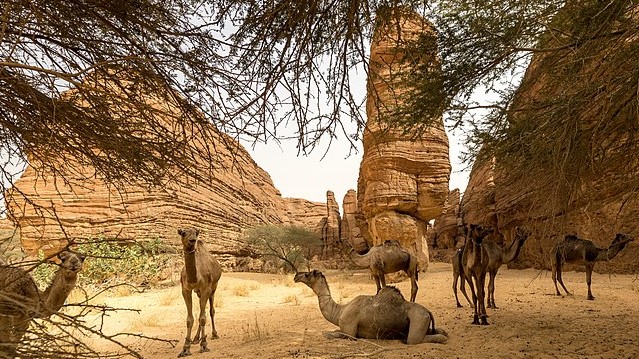By Mariam Djimet Nour
ENNEDI PLATEAU, CHAD — In the wind-worn sandstone of northeastern Chad, the past speaks in ochre and shadow.
High above the desert floor, tucked into caves and overhangs carved by millennia of erosion, are the silent testaments of early civilization—rock paintings and engravings that stretch back more than 8,000 years. Camels, giraffes, warriors, dancers. Each image, etched in mineral pigment or chiseled with stone tools, reflects a life once vibrant in what is now one of the most remote and arid corners of the planet.
This is the Ennedi Plateau—often called the “open-air museum” of the Sahara. Once forgotten by the world, it is now stepping into the global spotlight as scholars, travelers, and cultural heritage groups recognize it as one of humanity’s most precious archaeological treasures.
“Ennedi is not just rock art—it’s a conversation across time,” says Dr. Abakar Mahamat, a Chadian archaeologist who has spent the last decade documenting and protecting the region’s ancient imagery. “Every figure tells us who we were, how we lived, what we valued.”
In 2016, UNESCO inscribed the Ennedi Massif as a World Heritage Site, recognizing its exceptional natural formations and the cultural legacy preserved on its walls. The designation marked a turning point. Since then, international partnerships have helped fund conservation initiatives, including collaborations with the UNESCO World Heritage Centre and the African World Heritage Fund, aimed at protecting these fragile works from erosion, vandalism, and climate change.
The resurgence of interest has also ignited a new wave of archaeological exploration across Chad. Far beyond Ennedi, in the Sahelian belt and around the Lake Chad Basin, researchers are uncovering ruins of early kingdoms, burial sites, pottery fragments, and even fossil remains that date back to some of the earliest known hominins.
Among the most significant finds is the Djourab Desert’s Sahelanthropus tchadensis, nicknamed “Toumaï,” one of the oldest known ancestors of modern humans. Discovered in 2001, Toumaï’s 7-million-year-old skull is often cited in global debates about human origins, placing Chad firmly in the spotlight of paleoanthropology.
Today, local and national authorities are embracing this cultural renaissance. The Chadian Ministry of Culture and Tourism has launched new initiatives to train local heritage stewards, develop community-based tourism, and attract responsible investment into the preservation of archaeological sites. Their aim is not only to protect history, but to empower local communities to benefit from it.
In Goz Beïda and Borkou, small tour operations led by nomadic Toubou and Arab communities now guide adventurous travelers through rock labyrinths and into caves that whisper with ancient echoes. Revenues help fund schools, clinics, and sustainable water projects, forging a future rooted in the power of the past.
Internationally, art historians are calling Chad’s rock art a “missing chapter” in the global narrative of prehistoric expression. As institutions like the British Museum and the Institut de Recherche pour le Développement (IRD) in France deepen their partnerships with Chadian experts, new digitization projects are underway to record and share these fragile works with the world.
“Chad is not just a place of conflict or desert,” says Mariam Oumar, a heritage guide in Fada. “We are a land of wisdom, of story, of beauty carved into stone.”
As the sun sets over the ochre cliffs of Ennedi and shadows stretch across the sand, it’s not hard to imagine the people who once painted their lives in crimson and charcoal. Their art endures not only on rock, but now in the imagination of a world learning, finally, to listen.
Photo Credits: Ali Haroun / Chadian Ministry of Culture, UNESCO Archives, IRD Archives
Editor’s Note: This feature is part of a series highlighting Africa’s cultural heritage sites under transformation.
Sources:


